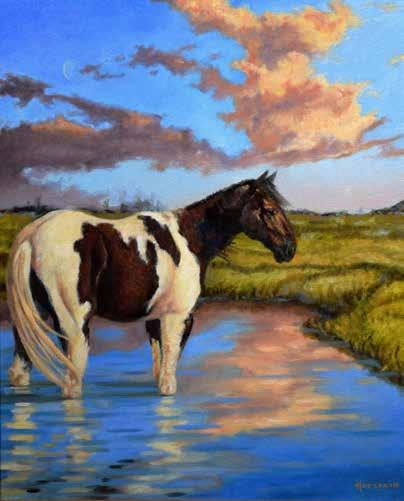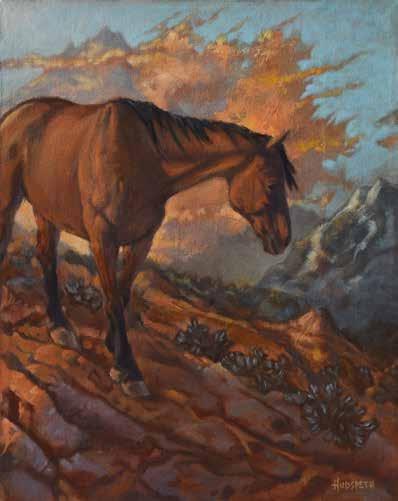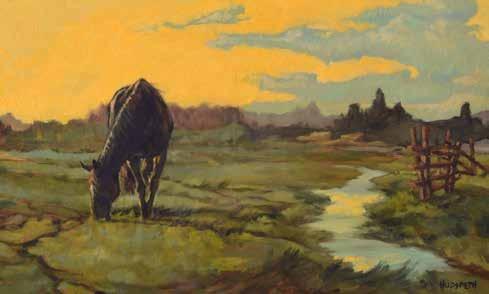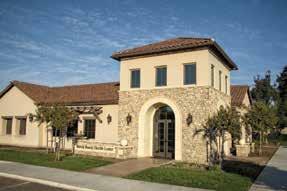
6 minute read
Visual Arts: Brent Hudspeth
Weight of Empathy
THE PAINTINGS OF
BRENT HUDSPETH
TEXT BY SHANE GUFFOGG
Brent Hudspeth is first and foremost an artist. Second, he is a native of Porterville. Like so many people who can call themselves natives, his grandparents and mom migrated from Oklahoma to the fertile soils of the Central Valley during the Dust Bowl era, in search of work and a means to survive.
Back in those days, the horse was an important part of life and hard work was the one thing that ensured a chance of putting food on the table. This backdrop is one that I am very familiar with having grown up in Lindsay and Strathmore, and it is one of the many reasons I gravitated towards Brent when we met at Porterville College back in 1981. We chose art as our major and, at that time, the college had one art teacher, making it impossible not to end up in the same classes. From day one, I recognized his drawing skills and saw him as someone to watch.
I graduated from Porterville College in 1983 and transferred to CalArts in Valencia. I recall Brent paying me a visit to see if CalArts — which redefined what a liberal art school was supposed to look like — was a place for him to continue his studies. Brent decided right then that CalArts was not a fit for him and set his sights on the other art school, Art Center College of Design in Pasadena. The school is widely known for graphic and transportation design (as in the look of cars), but instead Brent pursued the illustration and painting programs.
Brent graduated in 1989, staying in L.A. and working as an illustrator for some big companies for more than 20 years, saying, “I must add that at no time during this period of doing digital work for a living did I neglect my study of and interest in the process of painting with oils. I was continually painting and working in oils from the time I was at Art Center. When I was at Imagic in Hollywood, I showed a fellow digital artist some of my paintings and she said, ‘What are you doing here?’ Sometime in 1998, I became reacquainted with an instructor I had at Art Center, fine artist Harry Carmean. Harry is still a mentor, and he has shared so much with me about painting and the different ways of composing a painting.
“In 2004, I had noticed my folks were struggling more and more, and my grandparents were living by themselves out on Teapot Dome Avenue, where they had originally settled. In 2005, I decided to come back to Porterville to help my family. Both of my parents passed away within a year, followed by the loss of my grandparents.” Brent took over his grandparents’ ranch, coming full circle from where he started.
And then, Facebook brought us back in touch and I began following Brent's work that he was posting, marveling at his paintings of horses.
Now that we have a little background on Brent, I want to talk about art. Art begins as an idea. I want to emphasize the word idea because it is formed by who we are, and how we see and think about our world. Each of us has memories and, as one day becomes the next, these memories get layered and compressed, similar I think
Dream Plateau


Red Way Home

to how computers store information. These memories become memories of memories and begin to meld with other memories, creating a whole new picture. I say all of this because in October 2019, I went to an art opening in Exeter at the old Courthouse. The theme was horses and Brent Hudspeth's paintings of horses, set in a landscape of lush brush strokes with muted colors (muted as if by time); they were so quietly impactful that they now are etched into my memory.
I asked Brent about his point of view on horses and how they have been portrayed via art that he looks at versus how he sees and paints them now.
Brent Hudspeth: “Remington painted the horse as an element of the West. The horse was a part of the organic machinery of the frontier life, but Remington’s focus was on the human experience. The horse was a part of the fabric in the presentation of Remington’s depiction of the American West.
“The intent of my work is not to show the horse as an element, fixture or part of a whole statement. I am associating more with the implied personal state of mind of the horse as it relates to what we as humans may feel — triumph, jealousy, fear, lost love — right down to our core. There is honesty in the horse, the freedom to run away or to show the

real pain, unashamed without a mask of social bias. The horse in my paintings is a reflection of my own life, sorting out and sifting through all of the trauma and bliss of living. In my own way, I am contradicting myself as I hide behind the mask of the image of the horse. However, I do believe that contradiction is the essence of existence.
“Throughout my life, I have been on the back of horses and among them on the ground in so many circumstances. I see their attention to things and their yielding to other things. They breathe, they bleed, they feel and they bond emotionally.”
Brent Hudspeth's paintings are beautiful and haunting, familiar like a dream of watching a western on TV from childhood. There is a tranquil stillness that occupies these paintings. But there is something else happening and that something is Brent's ideas (which he so eloquently stated) that led him to create these oil on canvas works of art.
I wanted to know more. Brent explained that his images are from real life, books and the internet, and that he makes countless studies to truly understand the muscular structure of his subjects so that he can accurately depict moments that are an accumulation of his memories.
Brent's need to understand how a horse moves reminds me of Leonardo da Vinci's countless drawings he did to understand human anatomy. Leonardo wasn't painting a picture of a person; he was painting his idea of his subjects and what they represented. Brent's horses are just that, an idea of what a horse is now and what a horse was centuries ago. These paintings are his memories of moments, and ideas of a romantic bygone era
East of the Known
Field of Time
where a horse was off in the distance, waiting to carry the hero into the sunset.
There is an implied narrative in Brent's work that speaks to another era of how the San Joaquin Valley looked in the age of the horse, before the era of strip malls and parking lots. Brent Hudspeth's


paintings are more than just images of horses; his paintings are his personal
diary painted as a visual poem — one
that is meant to slow us down. These
paintings help us to see and better understand who we are and how we














